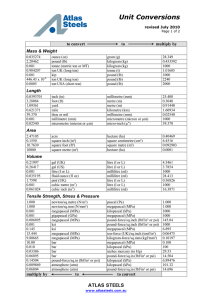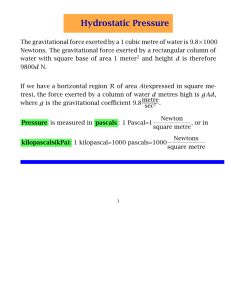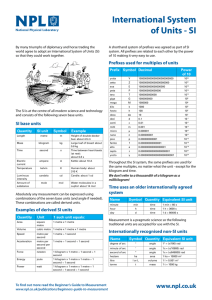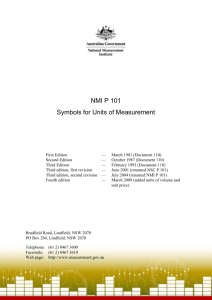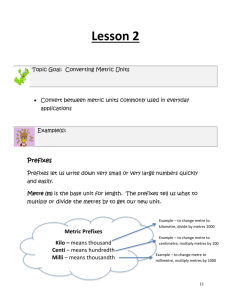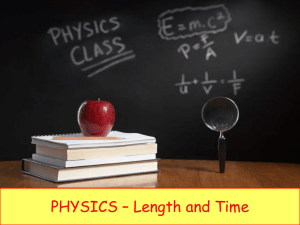SI units and Conversion factors
advertisement
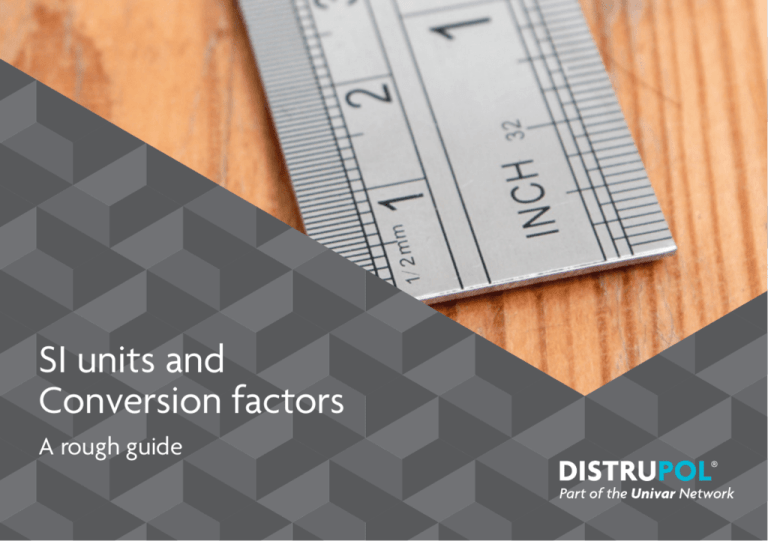
SI units and Conversion factors A rough guide The International Systems of Units (SI) The International Systems of Units (SI) is a modernized version of the metric system. SI is at present the latest version of the original metric system first proposed in France in 1670 and improved many times since then. The great advantage of the SI is that there is one and only one base unit for each physical quantity – the metre for length, the kilogram for mass, the second for time, etc. Units for all other mechanical quantities are derived from the base units. The derived units are definable by simple equations, such as: Velocity = length per time Force = mass x acceleration Power = work or energy per time Energy or work = force x distance SI Prefixes Multiplication factors Exponential Prefix SI system 1 000 000 000 000 000 000 = 10 = E+18 exa E 1 000 000 000 000 000 = 1015 = E+15 peta P 1 000 000 000 000 = 1012 = E+12 tera T 1 000 000 000 = 10 = E+09 giga G 1 000 000 = 10 = E+06 mega M 1 000 = 103 = E+03 kilo k 100 = 102 = E+02 hecto h 10 = 10 = E+01 deca da 1 = 10 = E+00 UNIT 0.1 = 10-1 = E-01 deci d 0.01 = 10-2 = E-02 centi c 0.001 = 10 = E-03 milli m 0.000 001 = 10 = E-06 micro µ 0.000 000 001 = 10-9 = E-09 nano n 0.000 000 000 001 =10-12 = E-12 pico p 0.000 000 000 000 001 =10 = E-15 femto f 0.000 000 000 000 000 001 =10 = E-18 atto a 18 9 6 1 0 -3 -6 -15 -18 Metre (m) The first definition of the metre was in terms of the earth’s circumference. The metre was to be constructed so that it would equal one ten-millionth of the distance from the North Pole to the equator along the meridian of the earth running near Dunkerque in France and Barcelona in Spain. However a yarning existed among metricians to base the length of the metre on some fact of nature and so the metre (m) is now define as the length equal to 1 650 763.73 wave lengths in vacuum of the radiation corresponding to the transitions between the levels, 2 p10 and 5d5 of the krypton-86 atom. Force Force = mass x acceleration = 1 kg x 9.81 m/s2 = 9.81 N 100 grams Force of 1 Newton (N) It has been suggested that an apple (about 100 grams) tossed into the air strikes the hand, on falling, with a force of about one Newton (N). If the same apple is made into apple sauce and spread over an area of one square metre, the pressure exerted would be equal to 1 Pascal (Pa) or 1 Newton per square metre. Energy & Time Energy Work in joules = Distance in metres x Force in newtons Energy 1 J = = = work done force (N) x distance (m) 1 N.m Time The base unit of time is the second. The definition is that the time duration of 9 192 631 770 periods of the radiation corresponding to the transition between the two hyperfine levels of the ground state of the cesium-133 atom. Mass (weigth) & Amount of substance Mass (weigth) The base unit of mass is the kilogram (kg). The international prototype of the kilogram is a particular cylinder of platinum (90%)-iridium (10%) alloy, about 3.8 cm high and 3.8cm in diameter, which is preserved in a vault at Sèvres, France, by the International Bureau of Weights and Measures. Amount of substance The amount of molecular substance is the mole, where one mole of any substance is the gram molecular weight of that material. For example, water (H2O); H2 = 2 x 1.008 (atomic weight of hydrogen) = 2.016 g O = 1 x 16 (at0mic weight of oxygen) = 16 g 1 mole of H2O = 18.016g Concentration (of the amount of substance) is the mole per cubic meter (mol/m3) Principle Conversation Factors 1 atmosphere, physical (atm) = 1.013 250 bar = 760 1 bar (bar) – unit of pressure = 0.986 923 atm mmHg (0 C) = 750.06 mmHg (00C) = 101.325 kPa = 100 000 Pa = 101 325 N/m = 100 kPa = 10.333 t/m = 10 N/cm2 = 14.696 lbf/in = 10.197 tf/m2 0 2 2 2 1 calorie – International (Int cal) = 4.186 8 J 1 carat – metric (-) – unit of mass = 200 mg 1 calorie – dietetic (cal) – unit of energy = 4.185 5 kJ 1 centimetre (cm) - unit of length = 0.3937 in = 10 mm = 0.01 m Principle Conversation Factors 1 cubic centimetre (cm3) 1 cubic metre (m3) – unit of volume = 0.001 L = 0.276 cord = 1000 mL = 1.308 yd3 = 0.035 195 fl oz (Cdn) = 35.3147 ft3 = 0.033 814 fl oz (US) = 219.969 gal (cdn) = 0.061 02 in3 = 264.172 gal (US) = 1000 kg =1 t =1 kL =1 Mg 1 foot (ft) – unit of length 1 foot per minute (ft/min) – unit of velocity = 304.8 mm = 5.08 mm/s = 30.48 cm = 0.3048 m/min = 3.048 dm = 18.288 m/h = 0.3048 m 1 foot pound-force (ft.lbf) = 1.356 1 furlong (-) – unit of length J = 201.168 m Principle Conversation Factors 1 grain (gr) – unit of mass = 64.798 91 1 gray (Gy) – absorbed energy per mass mg 1 hectare (ha) – unit of area =1 J/kg = 100 rads 1 inch (in) – unit of length = 100 ares = 25.4 mm = 0.01 km = 2.54 cm = 10 000 m = 0.0254 m = 2.471 054 acres 2 2 1 inch of mercury (inHg, 00C) – unit of pressure = 3.386 kPa = 33.86 mbar = 0.3386 N/cm 2 1 kilogram (kg) – unit of mass 1 joule (J) – unit of energy, work and heat =1 N.m =1 W.s = 0.239 g.cal = 9.484 x 10-4 Btu 1 kilogram calorie (kg.cal) – unit of energy = 1000 g = 3.9683 Btu = 0.001 t = 1.162 W.h = 2.204 62 lb = 4186 8 J Principle Conversation Factors 1 kilogram-force (kgf) – unit of force = 9.806 65 N 1 kilogram-force metre (kgf.m) – unit of energy 1 kilogram per cubic centimeter (kg/cm3) = 36.128 lb/in3 1 kilometre (km) – unit of length = 9.806 65 J = 0.621 371 mi = 9.806 65 N.m = 3280.84 ft = 1 x 10 mm 6 1 kilonewton (kN) – unit of force 1 kilopascal (kPa) – unit of pressure = 102 kgf =1 kN/m2 = 0.102 tf = 0.01 bar = 0.1124 tnf = 20.885 43 lbf/ft2 = 0.100 36 tonf = 0.145 0377 lbf/in2 1 kilowatt (kW) – unit of power = 3414.4 Btu/h = 3600 kJ/h 1 knot (kn) – unit of velocity = 1.852 km/h Principle Conversation Factors 1 litre (L) – unit of volume 1 metre (m) – unit of length =1 dm3 = 100 cm = 0.001 m3 = 1000 mm = 1000 cm3 = 3.280 84 ft = 1000 mL = 1.0936 yd = 33.81 oz fl (US) = 39.37 in = 0.264 172 gal (US) 1 metre per second (m/s) 1 mile per hour (mi/h) – unit of velocity = 3.6 km/h = 1.609 344 km/h = 2.236 936 mi/h = 0.447 04 m/s = 196 85 ft/min = 88 ft/min 1 newton (N) – unit of force 1 newton per square metre (N/m2) =1 (kg.m)/S2 =1 = 101.97 gf = 1 x 10-2 mbar = 0.224 808 lbf = 1 x 10 bar 1 ounce (US fl oz) = 29.537 Pa -5 1 pint (US pt) – unit of capacity mL = 0.473 176 L Principle Conversation Factors 1 pound per cubic inch (lb/in3) 1 pound-force (lbf) – unit of force = 27.679 g/cm = 27.679 kg/l 3 1 pound-force per square inch (lbf/in2) = 6.894 757 kPa 1 square centimetre (cm2) = 4.448 22 N 1 quart (US qt) – unit of volume = 946.36 mL square mile (mi2) – unit of area = 0.155 in2 = 258.9988 ha = 0.0001 m = 2.589 988 km2 = 100 mm2 2 1 ton long (ton) 1 ton short (tn) = 1.016 047 t = 0.907 185 t = 1016.047 kg = 907.185 kg = 1.12 tn = 0.892 857 ton Principle Conversation Factors 1 tonne (t) 1 ton-force short (tnf) = 1000 kg = 0.984 207 ton = 1.102 31 tn 1 ton-force per square inch (tnf/in2) = 13.789 5 MPa 1 watt per square foot (W/ft2) = 10.763 W/m2 = 8.896 443 kN 1 watt-hour (W.h) – unit of energy = 3600 J = 3.6 kJ 1 yard (yd) – unit of length = 91.44 cm = 0.9144 m www.distrupol.com European Corporate HQ Distrupol Finland Distrupol Norway Our comparator card range: T:+44 (0)1932 566 033 F: +44 (0)1932 560 363 E: info@distrupol.com T:+358 (0)20 7500 460 F: +358 (0)20 7500 469 E: info-finland@distrupol.com T:+46 (0)40 6353 080 F: +46 (0)40 6113 506 E: info-norway@distrupol.com Tough & Strong Metal Replacement Flame Retardant Flexible Distrupol BV Distrupol Ireland Distrupol Sweden T:+31 (0) 78 6250 181 F: +31 (0) 78 6250 053 E: info-benelux@distrupol.com T:+353 (0)1 4019 808 F: +353 (0)1 4019 853 E: info-ireland@distrupol.com T:+46 (0)40 6353 080 F: +46 (0)40 6113 506 E: info-sweden@distrupol.com Food & Drink High Temperature Medical Electrical Clear Distrupol Denmark Distrupol Latvia Distrupol UK T:+45 (0)39 612 223 F: +45 (0)39 612 266 E: info-denmark@distrupol.com T:+358 (0)20 7500 460 F: +358 (0)20 7500 469 E: info-latvia@distrupol.com T:+44 (0)1932 566 033 F: +44 (0)1932 560 363 E: info@distrupol.com Distrupol Estonia Distrupol Lithuania T:+358 (0)20 7500 460 F: +358 (0)20 7500 469 E: info-estonia@distrupol.com T:+358 (0)20 7500 460 F: +358 (0)20 7500 469 E: info-lithuania@distrupol.com

